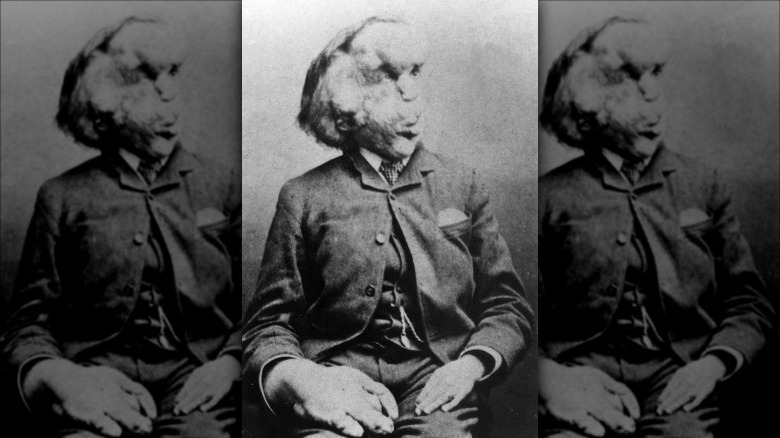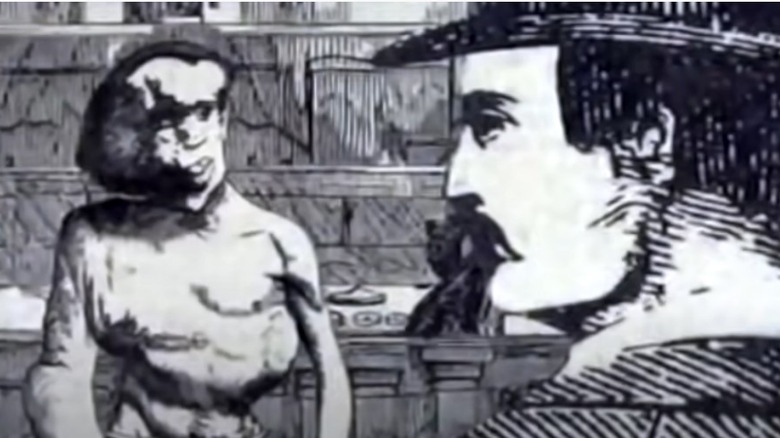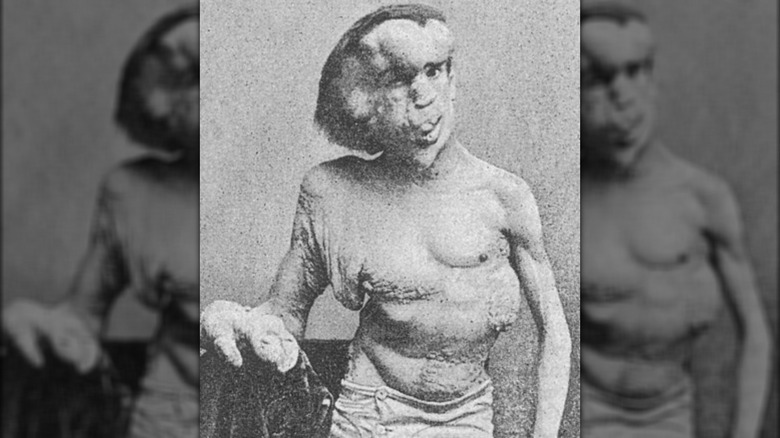How The Elephant Man, Joseph Merrick, Really Died
Although he later became known as "the elephant man," Joseph Merrick was an apparently normal-looking, healthy baby when he was born in 1862 in Leicester, England. In fact, there were no signs of Merrick being anything but a happy little boy until he turned 5 years old (via Britannica).
According to OpenMind, the first sign that something wasn't right was the appearance of a lip tumor that soon spread over one side of his face. Next, a lump appeared on his forehead, which would continue to grow over the next few years and resulted in a significant enlargement of his head. By the time he was an adult, his face and head had grown to 3 feet in diameter, partly due to the bony growths and partly due to the extra rough skin hanging from his face and head (per Britannica).
While his feet and his right arm also grew abnormally and his hip was defective, other body parts developed normally, giving Merrick an uneven appearance and causing difficulty when he walked and moved around. Because of its unique appearance and physical limitations, Merrick ended up living in a "workhouse," a sort of British asylum for the poor and the infirm (via Britannica). He eventually escaped and joined a freak show, where he was on display as "Half-a-Man and Half-an-Elephant." It was here that he was eventually discovered by a doctor and moved to a hospital, where his life would change forever.
What really caused the elephant man's to look like that
During his lifetime, Merrick was diagnosed as suffering from elephantiasis, a rare disease of the lymphatic system that causes certain parts of the body (especially the limbs) to become grossly enlarged (per Very Well Health).
This was the wrong diagnosis, and it would take more than 100 years before scientists would find a proper diagnosis to fit the condition that affected Merrick. Very Well Health reports that it wasn't until 1976 that the first alternative diagnosis was offered. At the time, scientists suggested he might have suffered from neurofibromatosis, a rare disorder that causes growths and tumors to appear on the eye or around it, abnormal curving of the pine, and larger than normal head circumference.
Twenty years later, a closer look at Merrick's skeleton suggested he might have suffered from Proteus syndrome instead. An extremely rare disorder that wasn't discovered until the late 20th century, Proteus syndrome offers a much better match to Merrick's symptoms, including benign tumors growing to very large sizes, a higher risk of pulmonary embolism, fatty growths, the rapid growth of the head or limbs in a "patchy" pattern (per Very Well Health). In modern times, Proteus syndrome is managed partly through repeated surgeries to remove growths, something that would have been too risky in the 1800s.
There's still an ongoing debate as to what exactly Merrick was suffering from. One of the newest theories is that he might have suffered from both neurofibromatosis and Proteus syndrome, a combination that could explain his sudden and unexpected death years later (per Open Mind).
A closer look into his health
Dr. Frederick Treves from The Royal London Hospital became interested in Merrick when he was still part of the freak show and often examined him in an effort to better understand his condition. Despite his physical appearance and his shocking measurements –- Treves reported Merrick's head was at one point 36 inches in diameter, while one of his fingers measured five inches in diameter –- Merrick was considered healthy by general standards (per My London News).
Of course, more serious issues connected to Proteus syndrome, such as the higher risk of seizures, blood clots, and pulmonary embolism, would have been impossible to detect back then (per Very Well Health). But by 19th-century standards, Merrick didn't appear to be a sick individual.
About two years after the initial contact with Treves, Merrick found himself on the streets before eventually being admitted to London Hospital. Merrick had pneumonia and his overall condition had deteriorated considerably over the previous two years. While his hospital stay was meant to be a short one, donations and support from public figures (including famous actress Madge Kendal) made it possible for Merrick to stay there for the rest of his life. Biography reports rooms at the hospital were adapted to become his living quarters, where Treves would visit him regularly.
Despite the best care available at the time, Merrick's tumors continued to grow and his overall condition continued to deteriorate. There just wasn't much a 19th-century doctor could have done to help "the elephant man."
An unexpected death
Despite his deteriorating condition, there were no obvious indications of anything life threatening going on with him. In fact, over the past few years before his death, he had lived a fuller life, engaging in outings to the theater and the countryside (via Biography).
In April 1890, however, Merrick was found dead on his bed at the age of 27. Most of his life, Merrick had slept sitting up, using his bent knees as a place to rest his head, according to Biography. While at London Hospital, he had a bed but would still sleep in an upright position, propped by pillows to help support the weight of his head.
But on that fateful night in 1890, Merrick had chosen to lie down on his bed. His cause of death was initially ruled as caused by asphyxiation. Basically, the weight of Merrick's head –- which is believed to have been around 20 lbs. –- had caused him to suffocate once he laid down.
Recent research, however, suggests this might not have been the case. Thomas Jefferson University Hospital's surgeon Alex Vaccaro was able to scan Merrick's skeleton (which has been held at The Royal London Hospital since his death) and then examine it as a computer model. The scan shows issues with some of Merrick's vertebrae, which Vaccaro believes explains his death: he likely crushed or severed his own spinal cord because of the weight of his head as he laid down on his bed -– for the first and last time (via Daily Mail).



